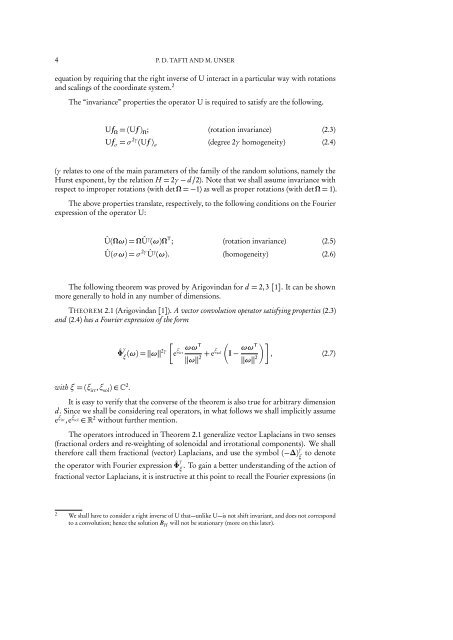FRACTIONAL BROWNIAN VECTOR FIELDS 1. Introduction. A one ...
FRACTIONAL BROWNIAN VECTOR FIELDS 1. Introduction. A one ...
FRACTIONAL BROWNIAN VECTOR FIELDS 1. Introduction. A one ...
Create successful ePaper yourself
Turn your PDF publications into a flip-book with our unique Google optimized e-Paper software.
4 P. D. TAFTI AND M. UNSER<br />
equation by requiring that the right inverse of U interact in a particular way with rotations<br />
and scalings of the coordinate system. 2<br />
The “invariance” properties the operator U is required to satisfy are the following.<br />
Uf Ω = (Uf ) Ω ; (rotation invariance) (2.3)<br />
Uf σ = σ 2γ (Uf ) σ (degree 2γ homogeneity) (2.4)<br />
(γ relates to <strong>one</strong> of the main parameters of the family of the random solutions, namely the<br />
Hurst exp<strong>one</strong>nt, by the relation H = 2γ − d/2). Note that we shall assume invariance with<br />
respect to improper rotations (with detΩ = −1) as well as proper rotations (with detΩ = 1).<br />
The above properties translate, respectively, to the following conditions on the Fourier<br />
expression of the operator U:<br />
Û(Ωω) = ΩÛγ (ω)Ω T ; (rotation invariance) (2.5)<br />
Û(σω) = σ 2γ Û γ (ω). (homogeneity) (2.6)<br />
The following theorem was proved by Arigovindan for d = 2,3 [1]. It can be shown<br />
more generally to hold in any number of dimensions.<br />
THEOREM 2.1 (Arigovindan [1]). A vector convolution operator satisfying properties (2.3)<br />
and (2.4) has a Fourier expression of the form<br />
<br />
ˆΦ<br />
e γ (ω) = ξ ‖ω‖2γ ξ ωω T<br />
irr<br />
‖ω‖ + 2 eξ sol<br />
I − ωωT<br />
, (2.7)<br />
‖ω‖ 2<br />
with ξ = (ξ irr ,ξ sol ) ∈ 2 .<br />
It is easy to verify that the converse of the theorem is also true for arbitrary dimension<br />
d. Since we shall be considering real operators, in what follows we shall implicitly assume<br />
e ξ irr ,e<br />
ξ sol ∈ 2 without further mention.<br />
The operators introduced in Theorem 2.1 generalize vector Laplacians in two senses<br />
(fractional orders and re-weighting of solenoidal and irrotational comp<strong>one</strong>nts). We shall<br />
therefore call them fractional (vector) Laplacians, and use the symbol (−∆) γ to denote<br />
ξ<br />
the operator with Fourier expression ˆΦ γ . To gain a better understanding of the action of<br />
ξ<br />
fractional vector Laplacians, it is instructive at this point to recall the Fourier expressions (in<br />
2 We shall have to consider a right inverse of U that—unlike U—is not shift invariant, and does not correspond<br />
to a convolution; hence the solution B H will not be stationary (more on this later).
















